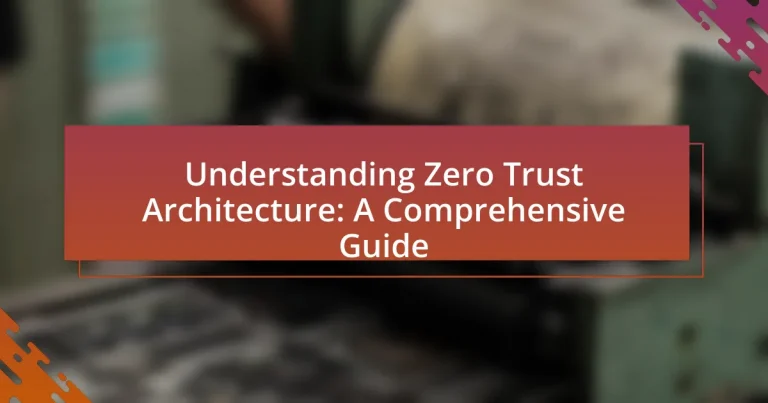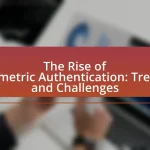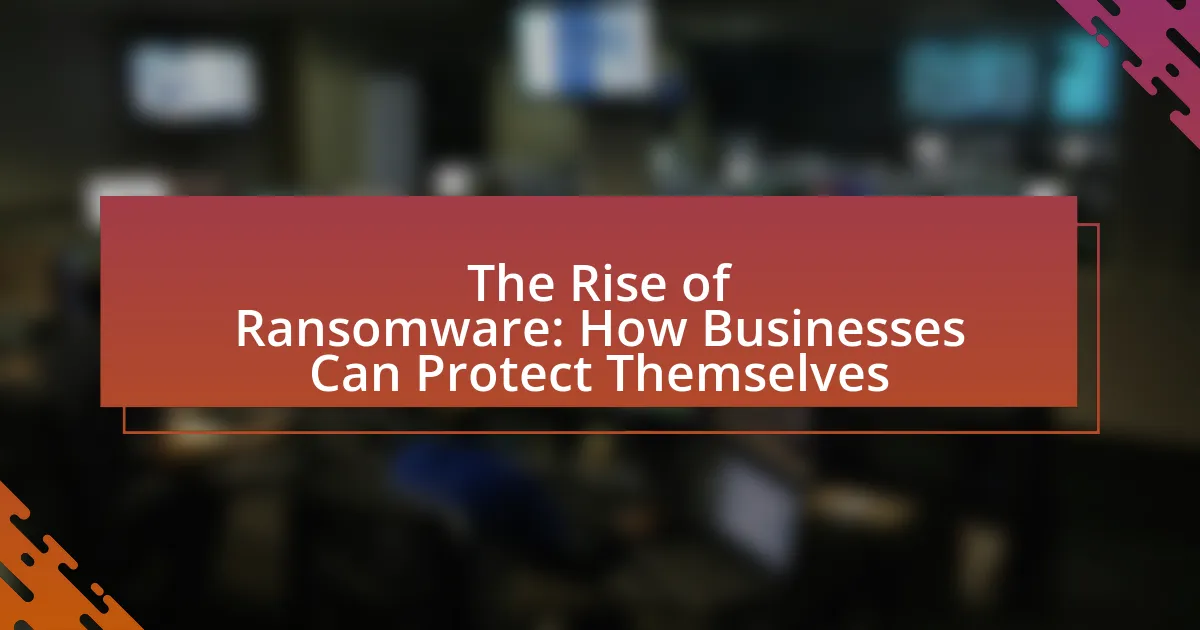Zero Trust Architecture (ZTA) is a cybersecurity model that mandates strict verification for every user and device accessing resources, regardless of their location. This approach contrasts with traditional security models by emphasizing continuous authentication and authorization, thereby addressing vulnerabilities from both internal and external threats. Key principles of ZTA include continuous verification, least privilege access, and micro-segmentation, which collectively enhance security and reduce the risk of data breaches. The article explores the components, benefits, implementation strategies, and future trends of Zero Trust, highlighting its effectiveness in improving organizational security posture and compliance with regulatory requirements.
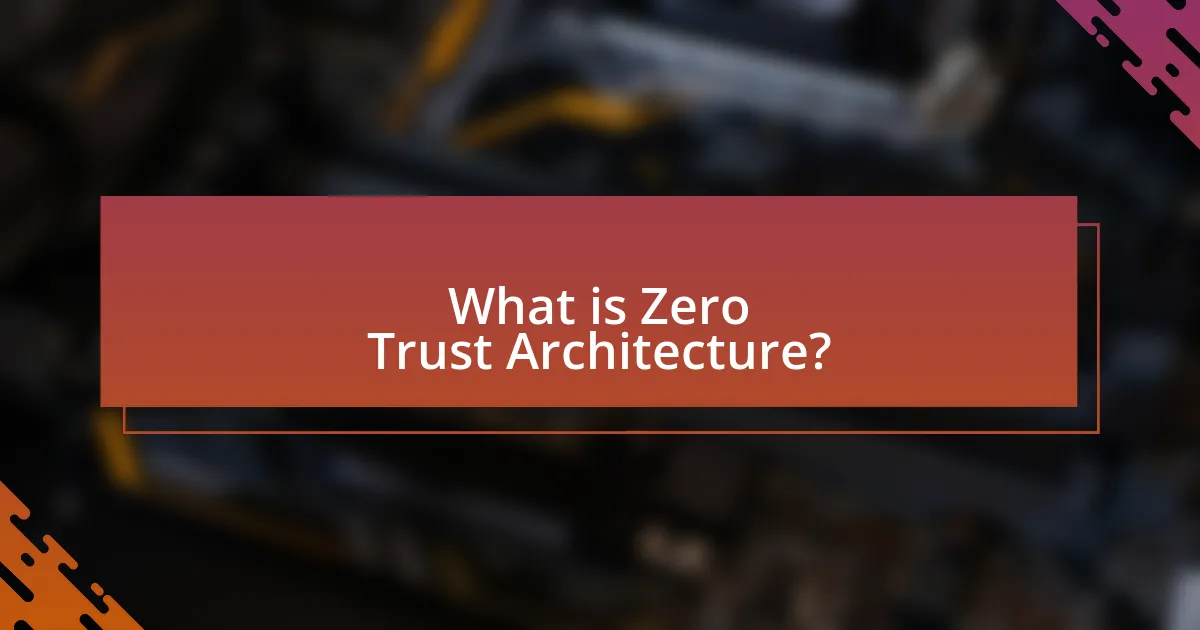
What is Zero Trust Architecture?
Zero Trust Architecture is a cybersecurity model that requires strict verification for every user and device attempting to access resources, regardless of whether they are inside or outside the network perimeter. This approach is based on the principle that threats can exist both inside and outside the network, necessitating continuous authentication and authorization. According to a 2020 report by Forrester Research, organizations implementing Zero Trust can reduce the risk of data breaches by up to 50%, highlighting its effectiveness in enhancing security.
How does Zero Trust Architecture differ from traditional security models?
Zero Trust Architecture (ZTA) fundamentally differs from traditional security models by adopting a “never trust, always verify” approach, whereas traditional models often rely on perimeter-based security. In ZTA, every user and device is authenticated and authorized regardless of their location, ensuring that access is granted based on strict identity verification and continuous monitoring. Traditional security models typically assume that users within the network perimeter are trustworthy, which can lead to vulnerabilities if an insider threat or breach occurs. This shift in focus from perimeter security to user and device-centric security is supported by the increasing complexity of modern IT environments and the rise of remote work, which necessitates a more robust security framework.
What are the key principles of Zero Trust Architecture?
The key principles of Zero Trust Architecture are continuous verification, least privilege access, and micro-segmentation. Continuous verification ensures that every user and device is authenticated and authorized before accessing resources, regardless of their location. Least privilege access restricts user permissions to only what is necessary for their role, minimizing potential damage from compromised accounts. Micro-segmentation involves dividing the network into smaller, isolated segments to limit lateral movement by attackers. These principles collectively enhance security by assuming that threats can exist both inside and outside the network perimeter, thereby requiring strict access controls and constant monitoring.
Why is the concept of “never trust, always verify” crucial?
The concept of “never trust, always verify” is crucial because it establishes a security framework that minimizes the risk of unauthorized access and data breaches. In a digital landscape where threats are increasingly sophisticated, relying solely on traditional perimeter defenses is inadequate. This principle mandates continuous verification of user identities and device integrity, regardless of their location within or outside the network. For instance, according to a 2020 report by Cybersecurity Insiders, 70% of organizations have adopted a Zero Trust model to enhance their security posture, demonstrating the effectiveness of this approach in mitigating risks associated with insider threats and compromised credentials.
What are the main components of Zero Trust Architecture?
The main components of Zero Trust Architecture include identity verification, device security, network segmentation, least privilege access, and continuous monitoring. Identity verification ensures that users are authenticated before accessing resources, while device security involves assessing the security posture of devices attempting to connect to the network. Network segmentation limits access to sensitive data by dividing the network into smaller, manageable segments. Least privilege access restricts user permissions to only what is necessary for their role, minimizing potential damage from compromised accounts. Continuous monitoring involves real-time analysis of user behavior and network traffic to detect anomalies and respond to threats promptly. These components collectively reinforce the Zero Trust principle of “never trust, always verify.”
How do identity and access management play a role in Zero Trust?
Identity and access management (IAM) is crucial in Zero Trust architecture as it ensures that only authenticated and authorized users can access resources. In a Zero Trust model, IAM enforces strict identity verification processes, such as multi-factor authentication and continuous monitoring, to mitigate risks associated with unauthorized access. This approach is supported by the principle that trust is never assumed, and every access request is evaluated based on user identity, device security, and contextual factors. According to a 2021 report by Forrester Research, organizations implementing IAM within a Zero Trust framework significantly reduce the likelihood of data breaches, highlighting the effectiveness of IAM in enhancing security posture.
What technologies support the implementation of Zero Trust?
Technologies that support the implementation of Zero Trust include identity and access management (IAM), multi-factor authentication (MFA), micro-segmentation, endpoint security, and security information and event management (SIEM). IAM ensures that only authorized users can access specific resources, while MFA adds an additional layer of security by requiring multiple forms of verification. Micro-segmentation limits lateral movement within a network, enhancing security by isolating workloads. Endpoint security protects devices that connect to the network, and SIEM provides real-time analysis of security alerts generated by applications and network hardware. These technologies collectively reinforce the Zero Trust model by ensuring strict access controls and continuous monitoring of user activity.
What are the benefits of adopting Zero Trust Architecture?
Adopting Zero Trust Architecture enhances security by ensuring that no user or device is trusted by default, regardless of their location. This approach minimizes the risk of data breaches by implementing strict access controls and continuous verification of user identities and device health. According to a study by Forrester Research, organizations that adopt Zero Trust can reduce the risk of a data breach by up to 50%. Additionally, Zero Trust Architecture improves compliance with regulations by providing detailed access logs and monitoring capabilities, which facilitate audits and reporting.
How does Zero Trust enhance security posture?
Zero Trust enhances security posture by enforcing strict access controls and continuous verification of users and devices. This model operates on the principle of “never trust, always verify,” meaning that every access request is treated as if it originates from an untrusted network. By implementing micro-segmentation and least privilege access, organizations can limit the potential attack surface and contain breaches more effectively. According to a study by Forrester Research, organizations that adopt Zero Trust can reduce the risk of data breaches by up to 50%, demonstrating its effectiveness in strengthening security measures.
What cost savings can organizations expect from Zero Trust?
Organizations can expect significant cost savings from implementing Zero Trust architecture, primarily through reduced data breach costs and improved operational efficiency. According to a study by Forrester Research, organizations adopting Zero Trust can reduce the average cost of a data breach by up to 30%. This reduction is attributed to enhanced security measures that limit unauthorized access and minimize the impact of potential breaches. Additionally, Zero Trust streamlines security management processes, leading to lower operational costs by reducing the need for extensive security personnel and resources. The combination of these factors results in a more cost-effective security posture for organizations.
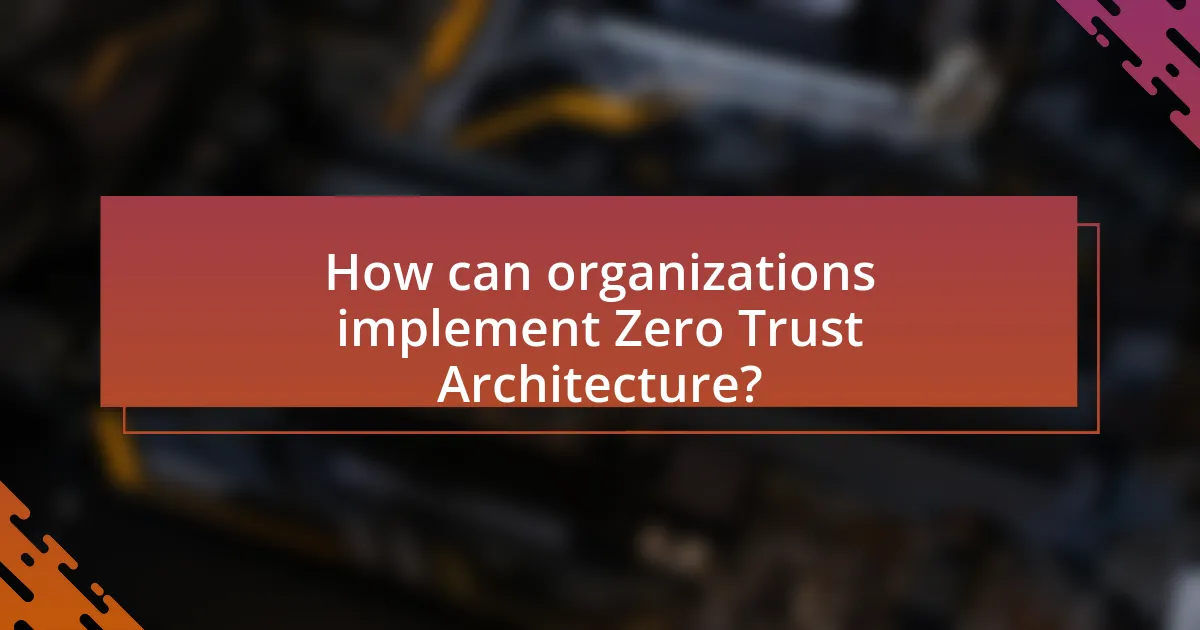
How can organizations implement Zero Trust Architecture?
Organizations can implement Zero Trust Architecture by adopting a strategy that requires verification for every user and device attempting to access resources, regardless of their location. This involves several key steps: first, organizations must identify and classify all data, assets, and services to understand what needs protection. Next, they should enforce strict access controls based on the principle of least privilege, ensuring users only have access to the resources necessary for their roles. Additionally, continuous monitoring and logging of user activities are essential to detect and respond to potential threats in real-time. Implementing multi-factor authentication further strengthens security by adding layers of verification. According to a 2021 report by Forrester Research, organizations that adopted Zero Trust principles saw a 50% reduction in security breaches, highlighting the effectiveness of this approach.
What are the steps to transition to a Zero Trust model?
To transition to a Zero Trust model, organizations should follow these steps: first, assess the current security posture to identify vulnerabilities and gaps in existing systems. Next, define the protection surface by determining critical assets, data, applications, and services that require safeguarding. Then, implement strict identity and access management protocols, ensuring that users are authenticated and authorized before accessing resources. Following this, segment the network to limit lateral movement and reduce the attack surface. Additionally, continuously monitor and analyze user behavior and network traffic to detect anomalies. Finally, establish a robust incident response plan to address potential breaches effectively. These steps are supported by industry best practices, such as those outlined by the National Institute of Standards and Technology (NIST) in their Cybersecurity Framework, which emphasizes the importance of continuous monitoring and risk assessment in achieving a Zero Trust architecture.
How should organizations assess their current security posture?
Organizations should assess their current security posture by conducting a comprehensive security assessment that includes vulnerability scanning, risk assessments, and security audits. This process involves identifying potential threats, evaluating existing security controls, and determining the effectiveness of those controls in mitigating risks. For instance, a study by the Ponemon Institute found that organizations that regularly conduct security assessments can reduce the likelihood of a data breach by up to 50%. Additionally, leveraging frameworks such as the NIST Cybersecurity Framework can provide structured guidance for evaluating security measures and identifying areas for improvement.
What role does employee training play in Zero Trust implementation?
Employee training is crucial in Zero Trust implementation as it ensures that all personnel understand security protocols and their responsibilities in maintaining a secure environment. Effective training programs educate employees about the principles of Zero Trust, such as least privilege access and continuous verification, which are essential for minimizing risks associated with insider threats and human error. Research indicates that organizations with comprehensive security training programs experience 70% fewer security incidents, highlighting the importance of informed employees in safeguarding sensitive data and systems.
What challenges might organizations face during implementation?
Organizations may face several challenges during the implementation of Zero Trust Architecture (ZTA). Key challenges include resistance to change from employees, as ZTA requires a shift in mindset regarding security protocols. Additionally, integrating existing systems with new ZTA frameworks can be complex, often leading to compatibility issues. Furthermore, organizations may struggle with the need for continuous monitoring and management of user access, which demands significant resources and expertise. According to a 2021 report by Forrester Research, 60% of organizations cited difficulties in aligning ZTA with their current security strategies as a major hurdle. These challenges highlight the necessity for careful planning and resource allocation during the implementation process.
How can organizations overcome resistance to change?
Organizations can overcome resistance to change by fostering open communication and involving employees in the change process. Engaging employees through transparent discussions about the reasons for change and its benefits can reduce uncertainty and build trust. Research indicates that organizations that actively involve employees in decision-making processes experience a 70% success rate in change initiatives, as highlighted in the Prosci Change Management Best Practices report. Additionally, providing training and support helps employees adapt to new systems, further mitigating resistance.
What technical hurdles are common in Zero Trust deployment?
Common technical hurdles in Zero Trust deployment include legacy system integration, user identity management, and data visibility challenges. Legacy systems often lack the necessary capabilities to support Zero Trust principles, making it difficult to enforce strict access controls. User identity management can be complex due to the need for continuous authentication and authorization, which requires robust identity solutions. Additionally, achieving comprehensive data visibility is challenging, as organizations must monitor and analyze user behavior across various environments to detect anomalies effectively. These hurdles can impede the successful implementation of a Zero Trust architecture.

What are the future trends in Zero Trust Architecture?
Future trends in Zero Trust Architecture include increased adoption of automation and AI for threat detection, enhanced integration with cloud services, and a focus on user identity and behavior analytics. As organizations face evolving cyber threats, automation and AI will streamline security processes, allowing for real-time responses to incidents. The shift to cloud environments necessitates seamless integration of Zero Trust principles, ensuring that security measures extend beyond traditional perimeters. Additionally, organizations will prioritize user identity verification and behavior monitoring to mitigate insider threats and improve access controls, reflecting a growing recognition of the importance of identity in security frameworks. These trends are supported by industry reports indicating that 70% of organizations plan to implement Zero Trust strategies by 2025, highlighting its increasing relevance in cybersecurity.
How is Zero Trust evolving with emerging technologies?
Zero Trust is evolving with emerging technologies by integrating advanced analytics, artificial intelligence, and machine learning to enhance security measures. These technologies enable real-time threat detection and response, allowing organizations to continuously assess user behavior and network traffic for anomalies. For instance, according to a report by Gartner, organizations implementing AI-driven security solutions can reduce incident response times by up to 90%. Additionally, the adoption of cloud services and remote work has necessitated a shift in Zero Trust strategies, emphasizing identity verification and device security across diverse environments. This evolution reflects the need for adaptive security frameworks that can respond to the complexities of modern IT infrastructures.
What impact will artificial intelligence have on Zero Trust strategies?
Artificial intelligence will significantly enhance Zero Trust strategies by improving threat detection and response capabilities. AI algorithms can analyze vast amounts of data in real-time, identifying anomalies and potential security breaches more efficiently than traditional methods. For instance, according to a report by Gartner, organizations that implement AI-driven security solutions can reduce incident response times by up to 90%. This capability allows for more proactive security measures, ensuring that access controls and user behaviors are continuously monitored and adjusted based on evolving threats.
How will regulatory changes influence Zero Trust adoption?
Regulatory changes will significantly accelerate Zero Trust adoption by mandating stricter security protocols and data protection measures. For instance, regulations such as the General Data Protection Regulation (GDPR) and the Health Insurance Portability and Accountability Act (HIPAA) require organizations to implement robust security frameworks to protect sensitive data. As compliance becomes a priority, organizations are increasingly turning to Zero Trust models, which emphasize continuous verification and least privilege access, to meet these regulatory demands. This shift is evidenced by a 2022 report from Cybersecurity Insiders, which found that 76% of organizations are adopting Zero Trust in response to regulatory pressures.
What best practices should organizations follow for effective Zero Trust?
Organizations should implement continuous verification, least privilege access, and micro-segmentation as best practices for effective Zero Trust. Continuous verification ensures that every user and device is authenticated and authorized before accessing resources, reducing the risk of unauthorized access. Least privilege access limits user permissions to only what is necessary for their role, minimizing potential damage from compromised accounts. Micro-segmentation divides the network into smaller, isolated segments, which helps contain breaches and restrict lateral movement within the network. These practices collectively enhance security by creating multiple layers of defense, making it significantly harder for attackers to exploit vulnerabilities.
How can continuous monitoring improve Zero Trust effectiveness?
Continuous monitoring enhances Zero Trust effectiveness by providing real-time visibility into user behavior and network activity. This ongoing surveillance allows organizations to detect anomalies and potential threats immediately, ensuring that access controls are dynamically adjusted based on current risk levels. For instance, according to a study by Forrester Research, organizations implementing continuous monitoring reported a 50% reduction in security incidents, demonstrating that timely insights can significantly mitigate risks associated with unauthorized access.
What role does incident response play in a Zero Trust framework?
Incident response is critical in a Zero Trust framework as it ensures rapid detection, containment, and remediation of security incidents. In a Zero Trust model, where no user or device is inherently trusted, incident response processes are designed to quickly identify breaches and minimize damage by enforcing strict access controls and continuous monitoring. This proactive approach is supported by the principle that security is a continuous process, requiring constant vigilance and adaptation to emerging threats. Effective incident response in this context relies on real-time data analysis and automated responses, which are essential for maintaining the integrity of the Zero Trust environment.
